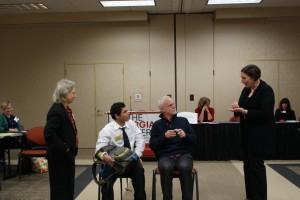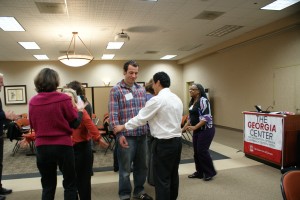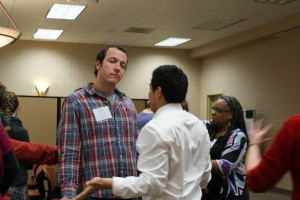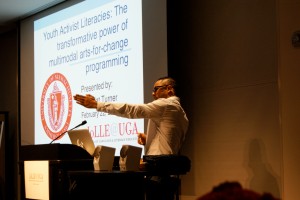Challenging Immigration Policies through Critical Performative Pedagogy
Reflections on our Workshop for JoLLE Activist Literacies Conference
Ruth Harman, Kinga Varga-Dobai, Monique Evans Newsome and Brittany Bogue
Anti-immigrant discourses and policies have posed daunting challenges for immigrant students and their communities in the Southeast of the United States in recent years (Allexsaht-Snider, Buxton, & Harman, 2012). A ban instituted by the University System of Georgia Board of Regents in October 2010, for example, prevents undocumented students from gaining admission to selective universities in the state regardless of high achievement records (Board of Regents Website). Senate Bill 160, recently approved in April 2013, may well prevent mixed-status immigrant families from accessing Medicaid and food stamps for their children.
As multicultural educators very troubled by these civil rights issues, we conducted a theater workshop at the conference where we used performance and critical discussion to embody and challenge these immigration policies. After engaging in warm-up Boalian games for actors such as body sculpting and mirroring activities, participants were asked to do free writes on personal experiences related to immigration (e.g. their own stories or those of their students). With three other participants they negotiated which story they would improvise for the whole group. In one mesmerizing scenario, the performers enacted a potentially very dangerous encounter between a Mexican immigrant driver and an overzealous police officer. Using Boalian techniques, members of the audience were encouraged to break into the scene and take on the role of the protagonist. One member of the audience, for example, changed the dynamics of the scene by enacting culturally responsive policing strategies.
In reflecting on our work for the conference, we believe that the ways in which our workshop participants engaged in the performance showed powerfully both the deep embodied knowledge they had of immigration issues and how the embodied re-enactment of painful experiences related to immigration helped us as a group to engage more deeply with the issues. This type of critical performance work can be used by educators and activist groups for social justice education (Enns & Sinacore, 2005; Nieto & Bode, 2012). In alignment with the main principles of social justice education as described by Enns & Sinacore (2005) critical performance enacts and affirms the experiences of those peoples who have been marginalized and opens discussion about resistance strategies and pedagogies that can be used to counteract egregious policies. In the context of teaching, critical performance allows for perspective taking and valuing of diversity, and promotes classroom climates built on equity.
Economically disadvantaged, undocumented residents, refugees, middle-class, struggling readers are all labels stamped upon our students’ educational passports. Critical use of performance supports teacher researchers to partner with students in collaborative youth participatory research that challenges institutional oppression (Cahill, 2007). Indeed, presenting Boalian scenarios to those who traditionally hold power allows students to have voice and dialogue with existing power structures. In sum, this work empowers educators to teach within the context of culture and to challenge the institutional structures of learning. Below we outline a sample lesson of activities for teaching in K-12 levels.
Our demonstration lesson for the conference: So far from the sea and Japanese American Incarceration during World War II
Rationale:
By imaginatively and experientially delving into scenarios that relate to specific socio- political and historical events, students begin to understand the complexity and multi- dimensional nature of history. Perhaps, the results of participatory and performative instruction will generate interest in readdressing issues of social justice.
Objectives:
- Students will be able to experientially connect to the concept of incarceration without trial.
- Students will explore strategic and tactical responses to social injustice and racial discriminatory practices related to immigration issues.
Questions to ask students after they sculpt their scenes:
Who are you? What is your story?
Where were you?
What did you want from the situation?
Was your story similar or very different from the sculptor’s master story?
Sequence of Activities in CPP Workshop
- Name Game and other Theater Games (Do regularly in class before workshop day)
- Reader’s Theater to activate discussion of key issue for group (e.g. immigration policies)
- Voting on emotions and counter emotions (Group vote on what emotions they would like to embody in their work)
- Body Sculpting and Museum Walk
- Debriefing with partner (What did you notice? What did you feel?)
- Journal write about personal experience related to immigration (or social issue being discussed) and triggered by the body work
- Story sharing and negotiation with three others on which story to tell
- Rehearsal of scene through silent sculpting of scene and verbal improvisation
- Jokers (facilitators) help groups to rehearse their scenes and encourage spect-actors to become involved in the scene as alternative protagonist
- Discussion of the scenes and strategies used by spect-actors
- Returning to the readings on immigration (connecting the theater work to the class curricular unit).
References
Allexsaht-Snider, M., Buxton, C., & Harman, R. (2012). Challenging anti-immigration discourses in school and community contexts. International Journal of Multicultural Education, 14(2).
Boal, A. (1974/1979). Theater of the oppressed. New York: Theater Communications Group.
Bunting, E. (1998). So far from the sea. Boston, MA: Clarion Books.
Cahill, C. (2007). The personal is political: Developing new subjectivities through
participatory actions research. Gender, Place and Culture. 14(3), 267-292.
Cahill, C. (2007). Doing Research with Young People: Participatory Research and the
Rituals of collective work. Children’s Geographies, 5 (3), 297-312.
Cahnmann-Taylor, M., & Souto-Manning, M. (2010). Teachers act up! Creating multicultural learning communities through theatre. New York, NY: Teachers College Press.
Conrad, D. (2004). Exploring risky youth experiences: Popular theatre as a
participatory, performative research method. International Journal of
Qualitative Methods, 3(1), 1-24.
Enns, C. & Sinacore, A. (2005). Teaching and social justice: Integrating multicultural
and feminist theories in the classroom. Washington, D.C.: American Psychological Association.
Freire, P. (2002). Pedagogy of the oppressed. New York, Continuum International.
Greene, M. (2001). Variations on a blue guitar: The Lincoln Center Institute lectures on aesthetic education. New York: Teachers College Press.
Harman, R. & French, K. (2004). Critical performative pedagogy: A feasible praxis in teacher education? In J. O’Donnell, M. Pruyn & R. Chavez (Eds.), Social justice in these times (pp. 97–116). Greenwich, CT: New Information Press.
Harman, R., & McClure, G. (2011). All the school’s a stage: Critical performative pedagogy in urban teacher education. Equity & Excellence in Education, 44(3), 379-402.
Harman, R. & Dobai-Varga, K. (2012). Critical performative pedagogy: Emergent bilingual learners challenge local immigration issues. International Journal of Multicultural Education,14(2), 1-17.
hooks, bell.(1994). Teaching to transgress: Education as the practice of freedom. New
York: Routledge.
Maher, F. & Tetreault, M. K. (1994, 2001). The feminist classroom: dynamics of gender, race and privilege, the expanded edition. United States of America: Rowman &
Littlefield Publishers, Inc.
Nieto, S. & Bode, P. (2012) Affirming diversity: The sociopolitical context of ulticultural education. 6th edition. Boston, MA: Pearson.
Nygreen, K. (2009). Critical dilemmas in PAR: Toward a new theory of engaged
research for social change. Social Justice, 36 (4), 14-35.
Speed, S. (2006). Indigenous women and gendered resistance in the wake of Acteal. In V.
Sanford & A. Angel-Ajani (Eds.), Engaged observer: Anthropology, advocacy, and activism (pp. 170-188). New Brunswick: Rutgers.





